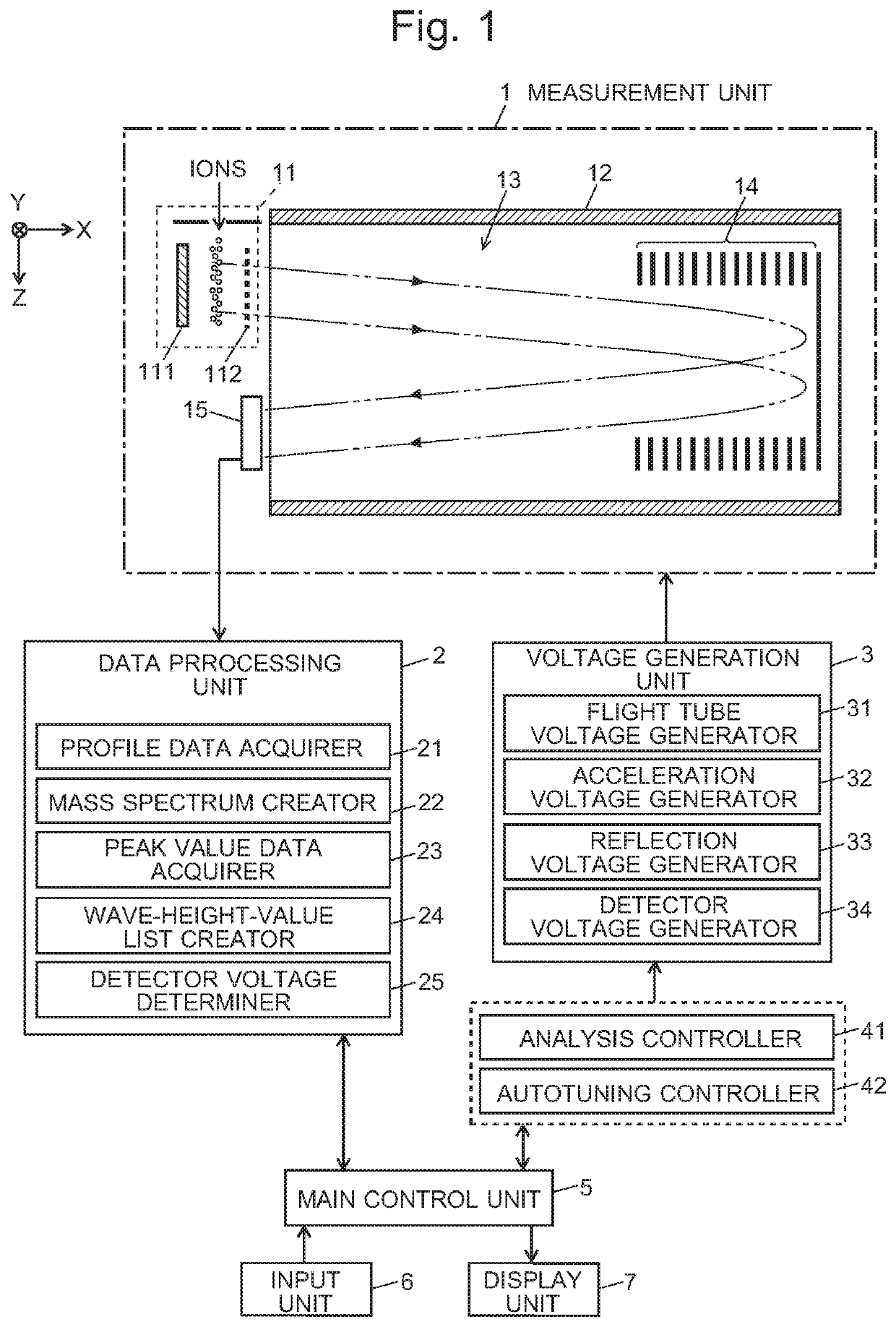Time-of-flight mass spectrometer
a mass spectrometer and time-of-flight technology, applied in energy spectrometers, dynamic spectrometers, particle separator tube details, etc., can solve the problem of insufficient intensity of signal corresponding to low-concentration components of sample samples, inability to determine whether the situation has been caused, and insufficient sensitivity. the effect of dynamic rang
- Summary
- Abstract
- Description
- Claims
- Application Information
AI Technical Summary
Benefits of technology
Problems solved by technology
Method used
Image
Examples
first modified example
[First Modified Example] Processing which Uses Number of Centroid Peaks
[0065]A profile spectrum has a continuous waveform in the temporal direction (or in the direction of the mass-to-charge ratio if the time axis is converted into the mass-to-charge-ratio axis). The mass spectrum creator 22 performs a centroid conversion of each peak detected in the profile spectrum to obtain a linear centroid peak. As is commonly known, the mass-to-charge ratio of a centroid peak is the position of the center of gravity of the original peak waveform. The height of the centroid peak is normally the area or height of the original peak waveform, although the height of the centroid peak is not important in the present case. Provided that each peak observed on a profile spectrum corresponds to an individual ion as described earlier, the number of centroid peaks equals the number of ions. Accordingly, each centroid peak is hereby assumed to be a pulse signal corresponding to an individual ion, and the d...
second modified example
[Second Modified Example] Processing which Uses Total of Intensities of Centroid Peaks
[0067]As opposed to the first modified example which does not use the intensity values of the centroid peaks for the determination of the detector voltage, the second modified example uses the intensity values of the centroid peaks for the determination of the detector voltage.
[0068]If the magnitude of the signal intensity corresponding to an individual ion in the detector 15 is equal to or less than a certain value, the peak corresponding to the individual ion will be treated as a noise peak and excluded from the detection even when the peak actually exists. Therefore, no centroid peak will be created for an individual ion if the magnitude of the signal intensity for the ion is not higher than a certain value. Accordingly, if a total ion chromatogram (TIC) is created by totaling the intensities of all centroid peaks within a predetermined time-of-flight range (or mass-to-charge-ratio range) which ...
third modified example
[Third Modified Example] Processing which Uses Total of Intensities of Peaks on Profile Spectrum
[0069]In the second modified example, the centroid TIC is used for the determination of the detector voltage. It is also possible to total the peak-top intensities of the peaks on the profile spectrum before the centroid conversion, in place of the intensities of the centroid peaks, to create a TIC to be used for the determination of the detector voltage.
[0070]That is to say, the detector voltage determiner 25 creates a TIC by totaling the peak-top signal intensities of all peaks detected within a predetermined time-of-flight range (or mass-to-charge-ratio range) which is supposed to correspond to the components in the standard sample in the profile spectrum, or the peak-top signal intensities of the peaks whose peak-top signal intensities are equal to or higher than a predetermined threshold. The relationship between this TIC and the detector voltage will also have an overall shape as sh...
PUM
 Login to View More
Login to View More Abstract
Description
Claims
Application Information
 Login to View More
Login to View More - R&D
- Intellectual Property
- Life Sciences
- Materials
- Tech Scout
- Unparalleled Data Quality
- Higher Quality Content
- 60% Fewer Hallucinations
Browse by: Latest US Patents, China's latest patents, Technical Efficacy Thesaurus, Application Domain, Technology Topic, Popular Technical Reports.
© 2025 PatSnap. All rights reserved.Legal|Privacy policy|Modern Slavery Act Transparency Statement|Sitemap|About US| Contact US: help@patsnap.com



